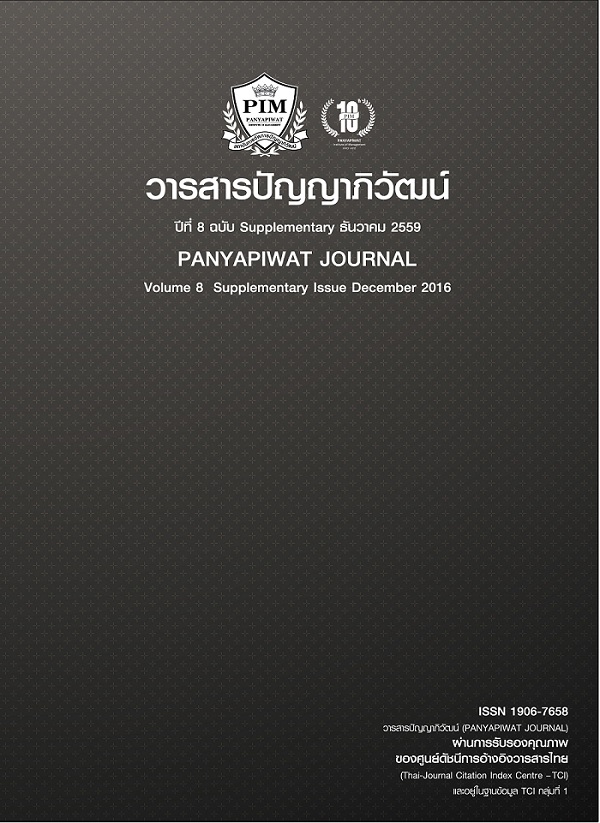THE RELATIONSHIP BETWEEN RETURNS OF CARRY TRADE STRATEGIES AND EQUITY MARKETS: THE EVIDENCE FROM DEVELOPED ECONOMIES AND ASEAN-5 EMERGING MARKETS
Main Article Content
บทคัดย่อ
This paper investigates the Granger causality relationship between returns of carry trade strategies and equity markets in developed economies and ASEAN-5 emerging markets. The Granger causality test under the Vector Autoregressive (VAR) model is employed using daily data from August 2006 to March 2015. The empirical results show that carry trade portfolio returns of G10 currencies strongly Granger cause returns of equity markets in all developed economies and ASEAN-5 emerging markets. Higher carry trade portfolio returns significantly lead to greater returns in most stock markets regardless of the environments they operate in. The implication of this study is that the US dollar has been more popular in funding for carry trade strategies than the Japanese yen. Conversely the currencies of all ASEAN-5 emerging markets have been used for investment purposes. For the case that excess returns of individual currency pairs are proxies for carry trade returns, both directions of the Granger causality relationship exist in most equity markets. Moreover, the results indicate that the yen is no longer a funding currency for carry trades.
งานวิจัยฉบับนี้ทำการตรวจสอบความสัมพันธ์แบบ Granger causality ระหว่างผลตอบแทนของธุรกรรม carry trade และผลตอบแทนของตลาดตราสารทุนในกลุ่มประเทศที่พัฒนาและกลุ่มประเทศเกิดใหม่ 5 ประเทศอาเซียน การศึกษาอาศัยการทดสอบ Granger causality ภายใต้ตัวแบบ Vector Autoregressive (VAR) โดยใช้ข้อมูลรายวันตั้งแต่เดือนสิงหาคม 2549 ถึงเดือนมีนาคม 2558 ผลการทดสอบแสดงให้เห็นว่า ผลตอบแทนจากพอร์ตการลงทุนธุรกรรม carry trade ที่ลงทุนในสกุลเงินของประเทศในกลุ่ม G10 ส่งผลกระทบต่อผลตอบแทนของตลาดตราสารทุนทั้งหมดในประเทศที่พัฒนาและกลุ่มประเทศเกิดใหม่ 5 ประเทศอาเซียน ผลตอบแทนจากพอร์ตการลงทุนธุรกรรม carry trade ที่สูงขึ้นส่งผลให้ผลตอบแทนของตลาดตราสารทุนส่วนใหญ่สูงขึ้นด้วยไม่ว่าจะอยู่ในกลุ่มประเทศใด ผลการทดสอบนี้ให้ความหมายโดยนัยที่แสดงให้เห็นว่ามีความนิยมกู้ยืมเงินดอลลาร์สหรัฐฯ ในฐานะสกุลเงินที่มีอัตราดอกเบี้ยต่ำเพื่อทำธุรกรรม carry trade มากกว่าเงินเยน ในทางกลับกันสกุลเงินของกลุ่มประเทศเกิดใหม่ 5 ประเทศอาเซียนทั้งหมดเป็นสกุลเงินที่ใช้สำหรับลงทุน สำหรับกรณีที่ใช้สกุลเงินคู่เดียวในการลงทุน เป็นตัวแทนการวัดผลตอบแทนของธุรกรรม carry trade นั้น ความสัมพันธ์แบบ Granger causality ทั้ง 2 ทิศทางเกิดขึ้นในตลาดตราสารทุนส่วนใหญ่ นอกจากนี้ผลการทดสอบได้ยืนยันว่าเงินเยนไม่ใช่สกุลเงินที่มีการกู้ยืมเพื่อทำธุรกรรม carry trade
Article Details
“ข้าพเจ้าและผู้เขียนร่วม (ถ้ามี) ขอรับรองว่า บทความที่เสนอมานี้ยังไม่เคยได้รับการตีพิมพ์และไม่ได้อยู่ระหว่างกระบวนการพิจารณาลงตีพิมพ์ในวารสารหรือแหล่งเผยแพร่อื่นใด ข้าพเจ้าและผู้เขียนร่วมยอมรับหลักเกณฑ์การพิจารณาต้นฉบับ ทั้งยินยอมให้กองบรรณาธิการมีสิทธิ์พิจารณาและตรวจแก้ต้นฉบับได้ตามที่เห็นสมควร พร้อมนี้ขอมอบลิขสิทธิ์บทความที่ได้รับการตีพิมพ์ให้แก่สถาบันการจัดการปัญญาภิวัฒน์หากมีการฟ้องร้องเรื่องการละเมิดลิขสิทธิ์เกี่ยวกับภาพ กราฟ ข้อความส่วนใดส่วนหนึ่งและ/หรือข้อคิดเห็นที่ปรากฏในบทความข้าพเจ้าและผู้เขียนร่วมยินยอมรับผิดชอบแต่เพียงฝ่ายเดียว”
References
Atanasov, V. & Nitschka, T. (2014). Foreign Currency Returns and Systematic Risks. Journal of Financial and Quantitative Analysis, 50(1/2), 231-250.
Bacchetta, P. & Wincoop, E. V. (2006). Can Information Heterogeneity Explain the Exchange Rate Determination Puzzle?. American Economic Review, 96(3), 552-576.
Bakshi, G. & Panayotov, G. (2013). Predictability of currency carry trades and asset pricing implications. Journal of financial economics, 110(1), 139-163.
Bansa, R. & Dahlquist, M. (2000). The forward premium puzzle: different tales from developed and emerging economies. Journal of International Economics, 51, 115-144.
Brunnermeier, M. K., Nagel, S. & Pedersen, L. H. (2009). Carry Trades and Currency Crashes. NBER Macroeconomics Annual 2008(23), 313-347.
Burnside, C., Eichenbaum, M. & Rebelo, S. (2007). The Returns to Currency Speculation in Emerging Markets. NBER Working Paper, (12916).
Christiansen, C., Ranaldo, A. & Söderlind, P. (2011). The Time-Varying Systematic Risk of Carry Trade Strategies. Journal of Financial and Quantitative Analysis, 46(4), 1107-1125.
Das, S., Kadapakkam, P. R. & Tse, Y. (2013). Is carry-trade a viable alternative asset class?. Journal of International Financial Markets, Institutions & Money, 24, 247-257.
Eichengreen, B., Hausmann, R. & Panizza U. (2007). Currency Mismatches, Debt Intolerance, and the Original Sin: Why They Are Not the Same and Why It Matters. National Bureau of Economic Research, 121-169.
Fama, E. F. (1984). Forward and Spot Exchange Rates. Journal of Monetary Economics,14, 319-338.
Froot, K. A. & Thaler, R. H. (1991). Anomalie: Foreign Exchange. The Journal of Economic Perspectives, 4(3), 179-192.
Fung, H. G., Tse, Y. & Zhao, L. (2013). Are stock markets in Asia related to carry trade?. Pacific-Basin Finance Journal,25, 200-216.
Gyntelberg, J. & Remolona, E. M. (2007). Risk in Carry Trades: A Look at Target Currencies in Asia and the Pacific. BIS Quarterly Review, 72-82.
Horobet, A., Dumitrescu, S. & Dumitrescu, D. G. (2009). Uncovered Interest Parity and Financial Market Volatility. The Romanian Economic Journal, 32, 21-45.
Ichiue, H. & Koyama, K. (2008). Regime switches in exchange rate volatility and uncovered interest parity. Journal of International Money and Finance, 30, 1436-1450.
Kavli, H. & Kotze, K. (2014). Spillovers in Exchange Rates and the Effects of Global Shocks on Emerging Market Currencies. South African Journal of Economics, 82(2), 209-238.
Kumar, M. (2013). Returns and volatility spillover between stock prices and exchange rates. International Journal of Emerging Markets, 8(2), 108-128.
Lothian, J. R. & Wu, L. (2011). Uncovered interest-rate parity over the past two centuries. Journal of International Money and Finance,30, 448–473.
Lustig, H., Roussanov, N. & Verdelhan, A. (2011). Common Risk Factors in Currency Markets. Review of Financial Studies, 24(11), 3731-3777.
McCurdy, T. H. & Morgan, I. G. (1991). Tests for a Systematic Risk Component in Deviations from Uncovered Interest Rate Parity. The Review of Economic Studies, 58(3), 587-602.
Melvin, M. & Taylor, M. P. (2009). The Crisis in the Foreign Exchange Market. Journal of International Money and Finance, 28(8), 1317-1330.
Menkhoff, L., Sarno, L., Schmeling, M. & Schrimpf, A. (2011). Carry Trades and Global Foreign Exchange Volatility. The Journal of Finance, 67(2), 681-718.
Pavabutr, P. & Sirodom, K. (2010). Mutual Fund Flows in Asian Equity Markets. CMRI Working Paper, 01/2010.
Plantin, G. & Shin, H. S. (2008). Carry Trades and Speculative Dynamics. Journal of accounting research, 46(2), 435-460.
Ranaldo, A. & Söderlind, P. (2009). Safe Haven Currencies. Forthcoming in Review of Finance, 1-28.Sarno, L., Valente, G. & Leon, H. (2006). Nonlinearity in Deviations from Uncovered Interest Parity: An Explanation of the Forward Bias Puzzle. Review of Finance, 10, 443-482.
Spronk, R., Verschoor, W. F. C. & Zwinkels, R. C. J. (2013). Carry Trade and Foreign Exchange Rate Puzzles. European Economic Review,60, 17-31.
Tse, Y. & Zhao, L. (2011). The Relationship between Currency Carry Trades and U.S. Stocks. The Journal of Futures Markets, 32(3), 252-271.
Verdelhan, A., Lustig, H. & Roussanov, N. (2011). Common Risk Factors in Currency Markets. The Review of Financial Studies, 24(11), 3731-3777.

